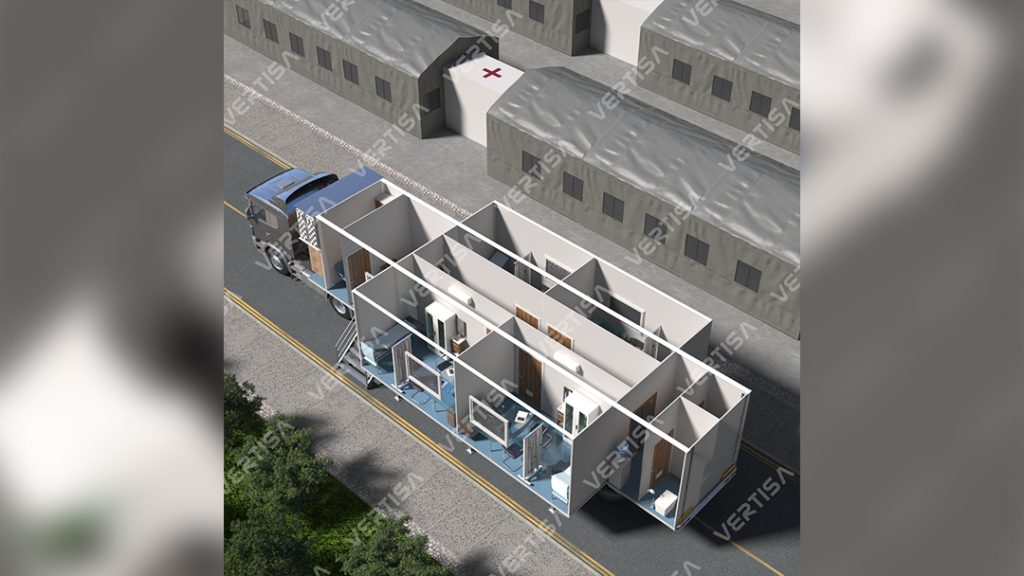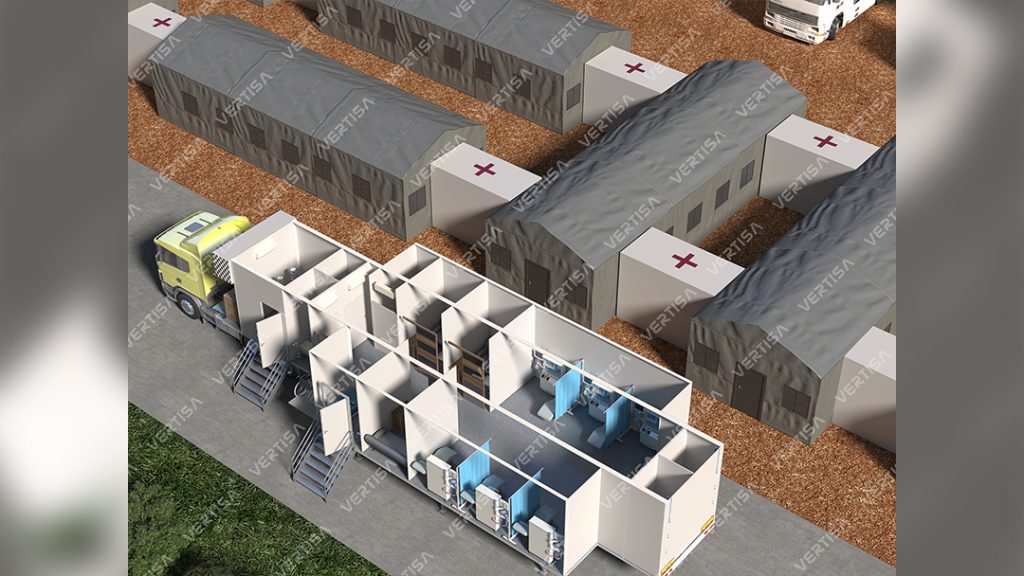Introduction:
In the ever-evolving landscape of healthcare, adaptability and efficiency have become paramount. The demand for innovative solutions to meet the dynamic needs of the healthcare sector has led to the rise of modular hospitals. These cutting-edge facilities are redefining the way we think about healthcare infrastructure, offering a flexible and fast solution that is revolutionizing the industry.
Healthcare systems worldwide are under constant pressure to provide quality care, respond to emergencies, and address sudden surges in patient numbers. Traditional hospitals, with their fixed structures, face challenges in meeting these demands swiftly. This is where the concept of modular hospitals steps in, introducing a paradigm shift in healthcare infrastructure.
Modular hospitals are designed to be agile, adaptable, and quick to deploy. Their design and construction principles allow healthcare facilities to respond rapidly to unforeseen circumstances, such as pandemics, natural disasters, or the need for temporary healthcare centers. These facilities can be tailored to specific needs, whether it’s creating additional capacity in a crisis or establishing a healthcare outpost in remote areas.
The key advantage of modular hospitals lies in their ability to reduce construction time significantly while maintaining high-quality healthcare standards. They are equipped with state-of-the-art medical technology, ensuring that patients receive the care they need without compromise.
This article will delve into the world of modular hospitals, exploring their advantages, design principles, case studies, and environmental sustainability. We will showcase real-world examples of how modular hospitals have been deployed successfully to address critical healthcare challenges. By the end of this comprehensive exploration, you’ll have a deeper understanding of how modular hospitals are reshaping healthcare infrastructure and driving innovation in the field.
Join us on this journey to discover how the “Modular Hospital Solution” is poised to transform the healthcare sector, offering a solution that is as versatile as it is effective. Together, we will unravel the many facets of this healthcare revolution.
Modular hospitals have gained significant attention in recent years, and for good reason. These innovative healthcare facilities offer a wide array of advantages that are reshaping the way we think about healthcare infrastructure. In this article, we will delve into the key advantages of modular hospitals and why they are becoming an increasingly popular choice for healthcare systems.
Rapid Deployment:
One of the standout features of modular hospitals is their ability to be deployed rapidly. Traditional hospital construction can take years, while modular hospitals can be up and running in a matter of months. This swiftness is especially crucial in emergency situations, such as natural disasters or pandemics, where healthcare facilities need to be established quickly to meet surges in patient numbers.
- Cost-Efficiency: Modular hospitals offer cost-efficiency by minimizing construction time and resource wastage. Their standardized design and construction processes lead to reduced labor and material costs. This cost-effectiveness makes them an attractive option for healthcare institutions working within budget constraints.
- Flexibility: Modular hospitals are designed with flexibility in mind. Their modular components can be easily adjusted and expanded to meet changing healthcare needs. Whether it’s adding more patient rooms, specialized units, or entire wings, modular hospitals can adapt to evolving demands without the need for extensive construction work.
- High-Quality Care: While modular hospitals are quick to deploy, they don’t compromise on the quality of care. They are equipped with state-of-the-art medical technology and adhere to strict healthcare standards. Patients can receive the same level of care as in traditional hospitals, ensuring that medical services remain top-notch.
- Scalability: The scalability of modular hospitals is a significant advantage. They can be scaled up or down based on requirements, making them ideal for both short-term and long-term healthcare solutions. This adaptability is especially useful in situations where healthcare demands fluctuate.
- Sustainability: Many modular hospitals are designed with sustainability in mind. They can incorporate eco-friendly practices and green building principles, reducing their environmental impact. This not only benefits the planet but also aligns with the growing emphasis on sustainability in healthcare.
- Redundancy and Backup: Modular hospitals can act as backup facilities in case of emergencies or during renovations of traditional hospitals. Their readiness to support existing healthcare infrastructure in times of crisis is a critical advantage.

Designing for Efficiency and Flexibility in Modular Hospitals
The design of modular hospitals is a key factor that sets them apart as innovative solutions for healthcare infrastructure. With an emphasis on efficiency and flexibility, these facilities are engineered to meet the ever-changing demands of healthcare systems in a rapidly evolving world.
Efficiency in design is a cornerstone of modular hospitals. Every aspect of their architecture, layout, and infrastructure is carefully planned to maximize the use of resources and space. This efficiency is crucial for healthcare institutions looking to provide top-quality care while optimizing costs. Here are some design elements that contribute to efficiency in modular hospitals:
- Standardization: Modular hospitals often follow standardized designs that can be replicated and adjusted as needed. This not only streamlines the construction process but also reduces the time required for planning and design. Standardized components can be manufactured off-site and assembled quickly, leading to significant time savings.
- Prefabrication: Many components of modular hospitals are prefabricated in controlled environments, allowing for better quality control and reducing construction delays due to weather or other on-site variables. This method of construction accelerates the building process.
- Optimized Layout: The layout of modular hospitals is designed to maximize space utilization. Patient rooms, medical facilities, and support services are organized for efficient patient care and staff workflow. This optimization ensures that healthcare professionals can provide the best care possible with minimal logistical challenges.
Flexibility in design is equally critical, allowing modular hospitals to adapt to changing circumstances and healthcare requirements. Here’s how flexibility is achieved in the design of these facilities:
- Adaptable Modules: Modular hospitals are constructed with adaptable modules that can be easily modified or expanded. This adaptability is crucial for healthcare systems that may need to respond to fluctuating patient numbers or changing medical specialties.
- Quick Reconfiguration: The ability to quickly reconfigure spaces within the hospital is a key feature. This allows healthcare institutions to respond to emergencies or changing patient needs rapidly. For example, a modular hospital can easily convert an ordinary ward into an intensive care unit if the situation demands it.
- Future-Proofing: Modular hospitals are designed with the future in mind. They are constructed to accommodate advancements in medical technology and changes in healthcare practices. This future-proofing ensures that the hospital remains a valuable asset for years to come.
Efficiency and flexibility in design are at the heart of modular hospitals, making them versatile and responsive to the dynamic demands of the healthcare sector. By combining these design principles, modular hospitals ensure that healthcare providers can deliver high-quality care efficiently while adapting to the ever-changing landscape of medicine and patient needs.
Modular Hospitals vs. Traditional Hospitals: A Comparative Overview
Modular hospitals and traditional hospitals represent two distinct approaches to healthcare infrastructure, each with its own set of advantages and limitations. Below, we provide a comparative overview of these two hospital types to highlight their key differences and help healthcare decision-makers make informed choices.
Construction Time and Deployment: Modular Hospitals: Modular hospitals are known for their rapid deployment. They can be designed, manufactured, and set up in a fraction of the time it takes to construct a traditional hospital. This agility is especially valuable in emergencies and scenarios requiring swift healthcare response. Traditional Hospitals: Traditional hospitals typically have longer construction timelines, often spanning several years. Their permanence and complexity necessitate extended planning and building phases.
Flexibility and Adaptability: Modular Hospitals: Modular hospitals excel in flexibility. Their modular components can be easily expanded or reconfigured to meet evolving healthcare needs. This adaptability is ideal for addressing fluctuating patient numbers or changing medical specialties. Traditional Hospitals: Traditional hospitals are less flexible in design, making major modifications or expansions a time-consuming and expensive endeavor. Their layouts are generally fixed, requiring substantial construction work for any adjustments.
Cost-Efficiency: Modular Hospitals: Modular hospitals are often more cost-efficient due to reduced construction time, standardized design, and controlled manufacturing processes. They can offer substantial cost savings, making them an attractive option for healthcare systems with budget constraints. Traditional Hospitals: Traditional hospitals can be expensive to build and maintain due to their complex, customized designs and longer construction periods. Ongoing operational costs may also be higher.
Quality of Care: Modular Hospitals: Modular hospitals maintain high-quality care standards by incorporating state-of-the-art medical technology and adhering to healthcare regulations. They ensure that patients receive the same level of care as traditional hospitals. Traditional Hospitals: Traditional hospitals offer a long-standing reputation for high-quality care. However, the quality of care in any hospital ultimately depends on the staff, equipment, and protocols in place.
Long-Term Viability: Modular Hospitals: Modular hospitals are designed to be long-lasting and can accommodate future advancements in medical technology and changes in healthcare practices. Their adaptability ensures continued relevance over time. Traditional Hospitals: Traditional hospitals, while durable, may face challenges in adapting to new healthcare trends and technologies, which can necessitate costly renovations.
In conclusion, the choice between modular hospitals and traditional hospitals depends on specific healthcare needs and priorities. Modular hospitals excel in rapid deployment, cost-efficiency, and adaptability, making them suitable for emergency responses and flexible healthcare solutions. Traditional hospitals offer a longstanding commitment to quality care but may require greater time and financial investments. Ultimately, the decision should consider the unique demands of the healthcare system and the communities they serve.
Conclusion: The Versatility of Vertisamodular
In conclusion, the comparative overview of modular hospitals and traditional hospitals demonstrates the unique advantages offered by Vertisamodular, an exemplary modular hospital solution. Vertisamodular stands out for its rapid deployment, cost-efficiency, flexibility, and adaptability, making it an ideal choice for addressing dynamic healthcare needs, whether in emergencies or long-term healthcare planning. With a commitment to high-quality care, sustainability, and long-term viability, Vertisamodular exemplifies the innovative and versatile future of healthcare infrastructure, ensuring that healthcare institutions can meet the evolving demands of our ever-changing world.



